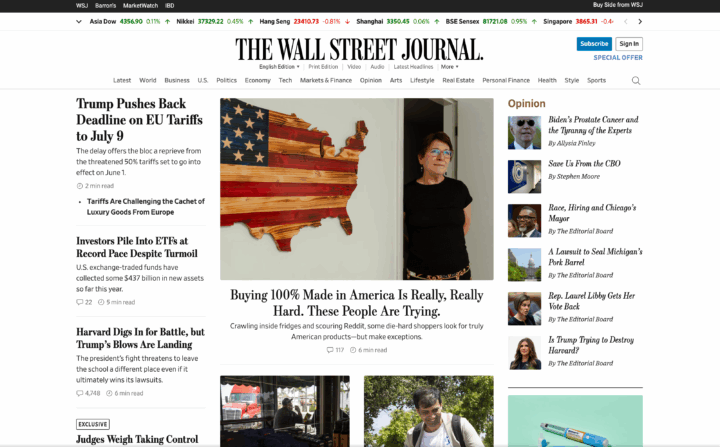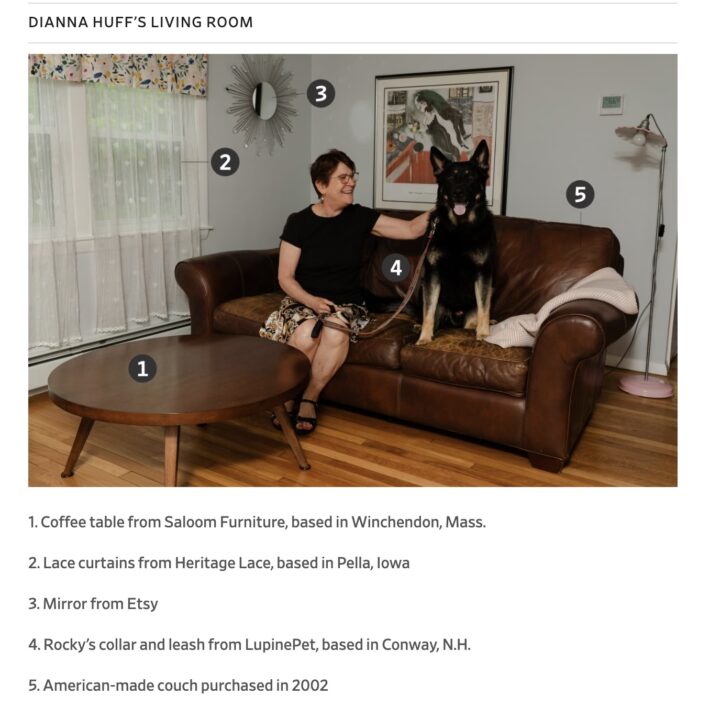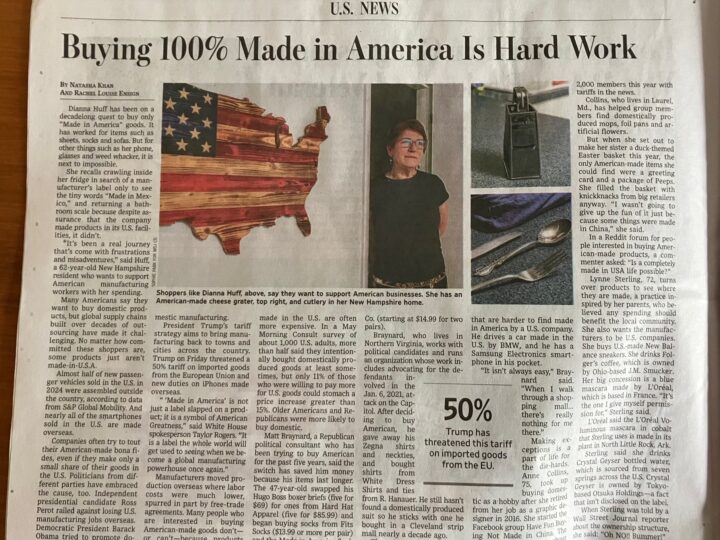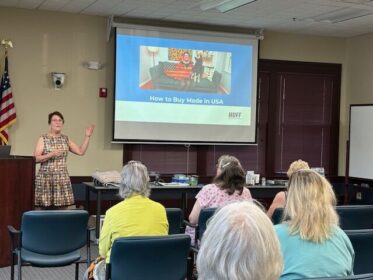
This post is a little different. I was featured in the U.S. News section of the Wall Street Journal, May 25, 2025. The lead up to the article, and the response once it was published, was like being on a roller coaster.
Several days later, I now feel like I’ve entered the station after a very thrilling ride — and can catch my breath.
I often marvel that despite being 9,000 miles apart, my friend and web designer Rachel Cunliffe and I have the same brainwaves. Rachel texted, “Write about your experience with the WSJ.”
Yes, on it!
“How did the WSJ find you?!”
A number of people have asked me this question. The answer is simple: LinkedIn. Yes, the social platform many of us love to complain about as being full of ads, weeks old feed posts, and a faulty algorithm that drives us insane.
Natasha Khan, reporter, reached out and asked if I were open to being interviewed about buying Made in USA products. (I think she said she searched for people who buy American-made products, and I popped up. Not sure!)
I’m not comfortable with the spotlight on me in a big way, so I asked a PR friend for advice and he said, “Yes. Do it — it’s a great opportunity.” I also realized it was time to get out of my comfort zone, so I said yes, albeit with some trepidation.
Natasha, however, was great! We spent 45 minutes on the phone talking. She was also with me through the entire process and kept me informed.
Want a clean house? Say “yes” to photography.
Natasha asked if I were open to a photographer coming by to take a photo of me and Rocky, and I said sure, not really understanding what I was getting myself into, haha.
Suddenly, it was two days before Sophie Park, the photographer, was due to arrive. OMG. I began cleaning like a mad woman — and a couple of hours before she was due, I put Rocky in the crate. It was raining buckets and each time he went out and came back in, he left muddy paw prints everywhere!
I thought Sophie would breeze by and take a photo of me sitting on the couch with Rocky. Ah nope. She was here for over two hours taking photos of *everything.* When she asked to see my closet, I was like, “Ummm . . . that’s where the skeletons are hidden.”
At the end, she said, “You’ve been a great sport about this. You have a lovely home, and I love your youthful energy. Thank you!” She also got a fantastic photo of Rocky — so it was all worth it. This one is from the WSJ online version.
I like how she really caught him — and smiling too! He was so excited about having a new friend in the house and kept jumping on and off the couch.

As an aside, everything in the photo was made in the U.S., except for the thermostat. Read my full “Made in USA living room” story.
The response: Amazing!
The article went live Sunday evening. Monday morning, while Rocky and I were at the town’s Memorial Day Parade, Natasha pinged me to say the London Times wanted to get in touch with me. Uhhh . . . really?! Then the BBC reached out.
People emailed to say congratulations, as did many on LinkedIn.
I also had to stop reading the WSJ comments section — brutal. A few people commented that my dog was a GERMAN shepherd versus an American mutt. Uh, what? That’s his breed, and he was born in Saco, Maine, thank you very much!
The story came out in the print version on Tuesday, May 27. I spent an hour driving all over town looking for copies. I scored two!

What I learned: Have your answers down pat — and set your own boundaries.
Since starting this journey in 2015, I’ve steered clear of politics, mostly because buying goods made here shouldn’t be political.
After the interview with London Times Radio, I realized I needed to be firm: no politics and no questions about tariffs.
I also learned that for radio interviews, you have to be brief — very brief — so it helps to have answers written for questions that get asked frequently.
“Does Made in USA cost more?”
This is the question I’m asked repeatedly. I used to hedge my answer, but now I’ve learned to be straight-forward.
Yes, it can cost more. My HF Coors dishes, for example, cost much more than anything I’d find at a store. So do the garments I buy from apparel manufacturers such as Sara Campbell or Vermont Flannel, or the Made in USA New Balance sneakers I purchased recently.
But as I told Greg Goodman, the COO of HF Coors — who emailed to say, “Congratulations!” — the benefits outweigh the costs. I buy far, far less stuff because everything I do buy is with intent. I have less clutter in my house, too. (Please ignore the dog toys!)
In the end, I spend less money, and everything I do have, I love and use.
When I use an item like my dishes, I’m filled with joy. I’m not just saying that. I don’t own a dishwasher and wash and dry them by hand. I love running my hands over their surface and admiring the wonderful craftsmanship.
The dishes will last the remainder of my life — and I fully expect my son will use them once I pass on. To me, it’s worth whatever I paid for them. We should have things in our lives that outlast us.
And, I love thinking about the craftspeople making the dishes. It’s why I buy Made in USA, whether 100% made here or not — because I want to support American manufacturing and the people who make the consumer or industrial products we all use.
By buying American-made, we help keep families, our local communities, and associated businesses, including farmers, truck drivers, etc., strong and viable.




